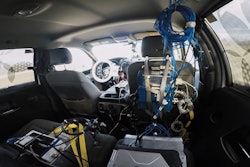With winter approaching, it’s time for many fleets and owner-operators to begin preparation for the months of cold temperatures ahead. As commercial vehicle technology advances and expands the use of compressed air for non-braking functions, proper care of pneumatic systems is crucial year-round; however, extra attention is typically needed in fall and early winter. As part of its Bendix Tech Tips series, Bendix Commercial Vehicle Systems LLC offers insight on preventive maintenance and cold-weather upkeep of compressed air systems.
Winter’s Water Woes
The complications of lower temperatures and air systems are less about the air and more about the moisture it contains: When the compressor draws in air, it also brings in that moisture, pumping both into the air dryer. If the moisture makes it past the air dryer, it can condense inside the air tanks and find its way into the rest of the braking system. Moisture in the air system is a problem at any temperature, but in cold weather, the condensed water can freeze, increasing the chance of malfunctions in brakes and valves.
“Air dryers have become increasingly critical as they protect not just braking systems, but the full range of components that use compressed air to help control things like automated manual transmissions, emissions controls, and other automated functions,” said Richard Nagel, Bendix director of marketing and customer solutions, air charging. “During winter, a number of factors can degrade a dryer’s ability to effectively remove moisture from the air: Trapped water can freeze and prevent valves from functioning properly; the stress of freeze-and-thaw cycles creates additional strain on components; and chemicals applied to roads can corrode the dryer’s purge valve.”
Air Dryer Cartridge Replacement
It often makes sense to replace air dryer cartridges annually in the fall, especially in cold climates, or on vehicles that consume higher air volumes, such as those in vocational applications. Equipping an air dryer with a high-quality original equipment (OE), manufacturer-supplied cartridge is one of the simplest and most cost-effective steps toward keeping moisture out of an air system.
Older dryers may require proprietary-style cartridges, while spin-on cartridges are more common on newer dryers. And spin-on cartridges often contain less desiccant material than some proprietary designs, making it even more important to prepare for adequate winter protection with a new cartridge. As air and moisture pass through the dryer during the system’s charge cycle, water molecules attach to the desiccant while the air continues into the tanks. During the purge cycle, the desiccant’s properties allow water molecules to detach, venting water through the dryer’s purge valve.
Because the type and quality of desiccant used affect the dryer’s performance, Bendix recommends using OE cartridges. With an ever-growing supply of aftermarket products on the market, OE replacements are the best way to ensure the use of reputably sourced and effective air drying technology rather than risk compromising a system’s ability to provide adequate winter protection.
Bendix also recommends using an oil-coalescing cartridge. Oil aerosols passed by the compressor can be particularly harmful to air systems. Oil deteriorates seals and contributes to premature damage in a variety of other components. It’s worth noting that the Bendix® PuraGuard® design efficiently removes oil from the air before reaching the desiccant, which also extends the dryer’s capability to remove moisture from the air. Standard cartridges may be replaced with oil-coalescing cartridges, but fleets must always change out oil-coalescing cartridges with like replacements.
Air Tanks and Purge Valves
A second simple step toward keeping the air system moisture-free in winter is manually draining the air tanks – periodically, based on the truck’s air usage. Up to once a month for vehicles with high air demand or every three months for a typical line haul truck is recommended. If moisture hasn’t been removed by the dryer – whether due to contaminated desiccant, a malfunctioning purge valve, or a lack of purge air supply – manually draining it from the tanks is a fail-safe method of removing it from the system.
An air dryer’s purge valve is especially susceptible to contamination in winter due to the abundance of water, chemical treatment, salt, and sand on many roads. Additionally, icing can occur around the valve due to the small amounts of water exhausted through it.
“On vehicles operating in conditions involving long-term exposure to cold or contaminants like road salts, annual purge valve replacement using an OE component is good preventive maintenance that can be scheduled along with installation of a new dryer cartridge,” Nagel said.
Dealing with System Freezes
Adequate preventive maintenance prior to winter, coupled with a high-quality air dryer and cartridge, goes a long way toward avoiding freeze-ups.
When part of a vehicle’s air system does freeze, however, the traditional fix has been to add alcohol or similar de-icing solutions until the affected area clears, but Bendix emphatically advises against this. The term “alcohol” covers a wide variety of chemicals, many of which can corrode the compounds used in brake system seals, or break down valve lubricants, causing leaks or valve malfunctions. Even methanol, a commonly used alcohol in de-icing solutions, can cause long-term damage.
Realizing that some situations may require drastic measures, such as if a truck is down and absolutely requires the use of a brake anti-freeze compound, the location of the alcohol addition will determine what downstream components might later be affected by corrosion or contamination. Try to determine the precise location of the freeze-up and limit application to that area, minimizing potential exposure to other areas of the air system.
When possible, if alcohol has been added to the system, it’s important to check for leaks around the brake valves if the O-rings were exposed to the anti-freeze compound. Leaks can be audible, or they can be detected through the use of a soap spray. If a valve is leaking, either replace the O-ring with a new one, or replace the entire valve with a new or remanufactured component.








